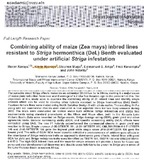| dc.contributor.author | Karaya, H. | |
| dc.contributor.author | Njoroge, K. | |
| dc.contributor.author | Nderitu, J. H. | |
| dc.contributor.author | Mugo, S. | |
| dc.contributor.author | Ariga, S. | |
| dc.contributor.author | Kanampiu, F. | |
| dc.date.accessioned | 2013-03-18T10:33:28Z | |
| dc.date.issued | 2012 | |
| dc.identifier.citation | International Journal of Plant Production 6 (2), April 2012 | en |
| dc.identifier.issn | 1735-6814 (Print) | |
| dc.identifier.issn | 1735-8043 (Online) | |
| dc.identifier.uri | http://erepository.uonbi.ac.ke:8080/xmlui/handle/123456789/14451 | |
| dc.description.abstract | Parasitism by Striga hermonthica (Del) Benth is a severe constraint in maize
production in sub-Saharan Africa. Varying levels of tolerance to Striga attack have
been identified and exploited in breeding programs of several crops. However, the
level and stability of the tolerance is generally unacceptable in field-practice. Only
limited exploration has been undertaken among the farmers’ landraces to find the
presence of viable sources of resistance to Striga. The objective of this study was to
examine and document the presence of the Striga germination stimulants from a
collection of some 420 maize landraces, populations and elite inbred lines. The
genotypes were variously sourced from International Maize and Wheat Improvement
Center (CIMMYT), International Institute for Tropical Agriculture (IITA) and Kenya
Agricultural Research Institute (KARI). The ability to effect germination as a
measure of the amount of germination stimulant produced was used to assess the
materials, using the standard procedures. Data were recorded on Striga germination
by counting Striga seeds with protruding radicle. Highly significant (P=0.001)
differences were observed among the germplasm screened. Several landraces were
found to stimulate low levels of Striga germination compared to the commercial
checks. Landraces CRIC 51, CUBA T-31, BRAZ 1758, BRAZ 1279 and VERA 217
exhibited the lowest Striga germination, an indication of high level of resistance to
Striga. The inbred lines were found to have a higher Striga germination percent
compared to the landraces, a likelihood of a higher concentration of strigol, the
stimulant causing chemical. CIMMYT lines CML 202 IR, CML 445 IR and CML
204 IR induced the least amount of Striga seeds to germinate. Higher levels of
germination of Striga seeds were found in the IITA lines which are known to be
resistant, depicting a probable avoidance root architecture mode of resistance as
opposed to low production of strigol. It was concluded that the landraces with low
Striga germination percent can be used by breeders in the extraction of new Striga
resistant inbred lines. The resistant inbred lines can be recommended for direct use in
the formation of maize synthetics and hybrids resistant to S. hermonthica. | en |
| dc.language.iso | en | en |
| dc.publisher | GUASNR | en |
| dc.subject | Striga hermonthica; Maize landraces; Tolerance to Striga; Resistance to Striga; Striga germination stimulant. | en |
| dc.title | Determination of levels of Striga germination Stimulants for maize gene bank accessions and elite inbred lines | en |
| dc.type | Article | en |
| local.publisher | International Maize and Wheat Improvement Center (CIMMYT) | en |
| local.publisher | University of Nairobi, Faculty of Agriculture, Upper Kabete Campus, | en |



